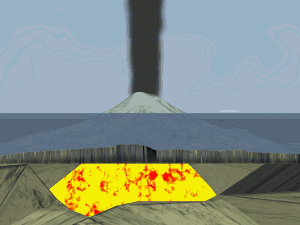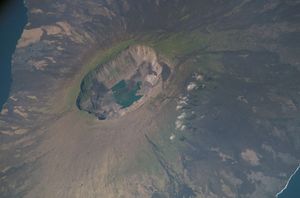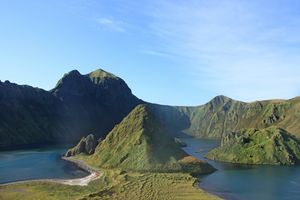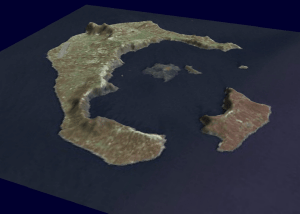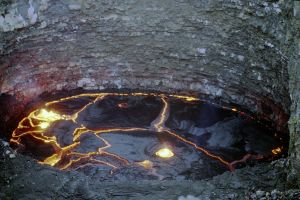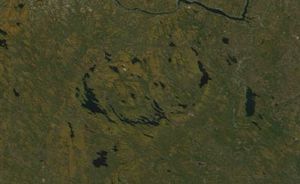كالديرا
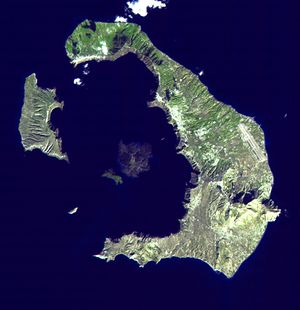
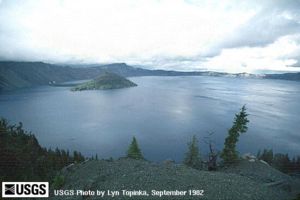
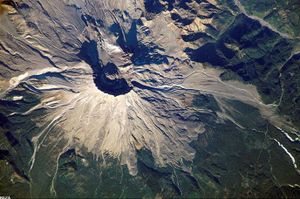
الكالديرا Caldera منخفض ضخم حوضي الشكل ناشئ عن انهيار الجزء الأوسط من بركان أو من انفجارات عنيفة إلى حد استثنائي. وهي إحدى الظواهر الجيومورفولوجية المصاحبة للبراكين، وأصل التسمية يعود إلى كلمة أسبانية معناها الدست أو الوعاء الكبير Cauldron ، وهي تستخدم للتعبير عن الفوهات البركانية الضخمة التي تبدو في شكل أحواض واسعة في قمم البراكين، واتخذ هذا الاسم من حفرة لاكالديرا Lacaldera في جزر الكناري التي يبلغ قطرها في أوسع جهاتها نحو 6 كم، ويتراوح عمقها بين ( 900 – 1650 ) كم، ويبدو الجبل الذي تشغل قمته تلك الحفرة من بعيد في شكل مخروط مقطع الجوانب.
وتشغل أحواض الكالديرا العديد من أفواه البراكين في العالم ، وقد تكون بعضها نتيجة انفجارات بركانية عملاقة استطاعة تدمير قمم المخروطات البركانية القديمة. ويعتقد إن بعض الكالديرا تتكون عندما تنهار قمة البركان في حجرة الصهير المفرغة بشكل جزئي بالأسفل، وعلى سبيل المثال فان بحيرة كريتر في أوريگون التي تحتل منخفض عرضه بحــدود 8 – 10 كم، وبحدود 1300 متر عمقاً، قد بدا في التكوين قبل حوالي 7000 سنة عندما أنتج البركان الذي سمي بعد ذلك جبل مازاما Mount Mazama ، انفجار رماد عنيف يشبه كثيرا ما أنتجه بركان فيزوف الذي قذف ما يقدر بحدود من ( 50 – 70 ) كم مكعب من المادة البركانية ، وانهيار 1500 متر من 3600 متر كانت بارزة من المخروط، وبعد الانهيار فان مياه الأمطار ملأت الكالديرا، إما النشاط الذي تلي ذلك فانه ساعد على بناء مخروط نفاية صغير يدعى جزيرة ويزارد Wizard island .
تصبح غرفة الصهارة فارغة كليا أو جزئيا، بعد الثورة العنيفة التي تندفع فيها أحجام كبيرة من الصهارة من غرفة الصهارة المتواجدة على بعد عدة كيلومترات قليلة تحت مخرج البركان، ثم يهبط ببطء سقف غرفة الصهارة غير المدعم تحت تأثير وزنها وينهار من خلال حلقة من الكسور الرأسية شديدة الأنحدار، تاركا منخفضا كبيرا على شكل حوض، أكبر بكثير من فوهة البركان، يسمي كالديرا.
. . . . . . . . . . . . . . . . . . . . . . . . . . . . . . . . . . . . . . . . . . . . . . . . . . . . . . . . . . . . . . . . . . . . . . . . . . . . . . . . . . . . . . . . . . . . . . . . . . . . . . . . . . . . . . . . . . . . . . . . . . . . . . . . . . . . . . . . . . . . . . . . . . . . . . . . . . . . . . . . . . . . . . . .
تكوّن الكالديرا
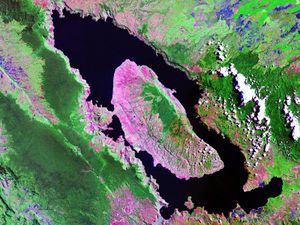
تتميز الكالديرات بمعالمها المميزة، حيث يتراوح قطرها بين بضعة كيلومترات و50 كم أو أكثر. ويعتقد بعض الجولوجيين أن الكالديرا تتكون بسبب انفجار هائل في البركان ينسف قمته، بينما أظهرت البحوث ورسم الخرائط الجيولوجية لأنماط التصدع حول الكالديرات أن الكالديرا تحدث نتيجة انهيار سقف غرفة الصهارة، وقد تتراكم مياه في الكالديرا لتكون بحيرة.
انفجارات الماء البركاني (انفجار فرياتي)
عندما تقابل صهارة ساخنة غنية بالغاز ماءا جوفيا أو ماء بحر، تنشأ كميات ضخمة من بخار الماء الشديد السخونة تصحبها الطين والمواد الأخرى، دون توهج. ومن هذا النموذج انفجار بركان كراكاتوا في أندونيسيا عام 1883م، وهو أحد أكثر الانفجارات البركانية تحطيما وتخريبا في التاريخ.
التمعدن في الكالديرات
بعض الكالديرات معروف أنها تضم rich ore deposits. Metal-rich fluids can circulate through the caldera, forming hydrothermal ore deposits للفلزات مثل الرصاص والفضة والذهب والزئبق والليثيوم واليورانيوم.[1] واحدة من أفضل الكالديرات المتمعدنة حفاظاً هي Sturgeon Lake Caldera في شمال غرب أونتاريو، كندا، التي تشكلت أثناء Neoarchean era[2] about 2,700 million years ago.[3]
أنواع الكالديرات
كارديرات متفجرة
توبا
كالديرات غير متفجرة
الكالديرات خارج كوكب الأرض
Since the early 1960s, it has been known that volcanism has occurred on other planets and moons in the Solar System. Through the use of manned and unmanned spacecraft, volcanism has been discovered on Venus, Mars, the Moon, and Io, a satellite of Jupiter. None of these worlds have plate tectonics, which contributes approximately 60% of the Earth's volcanic activity (the other 40% is attributed to hotspot volcanism).[4] Caldera structure is similar on all of these planetary bodies, though the size varies considerably. The average caldera diameter on Venus is 68 km (42 mi). The average caldera diameter on Io is close to 40 km (25 mi), and the mode is 6 km (3.7 mi); Tvashtar Paterae is likely the largest caldera with a diameter of 290 km (180 mi). The average caldera diameter on Mars is 48 km (30 mi), smaller than Venus. Calderas on Earth are the smallest of all planetary bodies and vary from 1.6–80 km (1–50 mi) as a maximum.[5]
القمر
القمر has an outer shell of low-density crystalline rock that is a few hundred kilometers thick, which formed due to a rapid creation. The craters of the Moon have been well preserved through time and were once thought to have been the result of extreme volcanic activity, but actually were formed by meteorites, nearly all of which took place in the first few hundred million years after the Moon formed. Around 500 million years afterward, the Moon's mantle was able to be extensively melted due to the decay of radioactive elements. Massive basaltic eruptions took place generally at the base of large impact craters. Also, eruptions may have taken place due to a magma reservoir at the base of the crust. This forms a dome, possibly the same morphology of a shield volcano where calderas universally are known to form.[4] Although caldera-like structures are rare on the Moon, they are not completely absent. The Compton-Belkovich Volcanic Complex on the far side of the Moon is thought to be a caldera, possibly an ash-flow caldera.[6]
المريخ
The volcanic activity of Mars is concentrated in two major provinces: Tharsis and Elysium. Each province contains a series of giant shield volcanoes that are similar to what we see on Earth and likely are the result of mantle hot spots. The surfaces are dominated by lava flows, and all have one or more collapse calderas.[4] Mars has the largest volcano in the Solar System, Olympus Mons, which is more than three times the height of Mount Everest, with a diameter of 520 km (323 miles). The summit of the mountain has six nested calderas.[7]
الزهرة
Because there is no plate tectonics on Venus, heat is mainly lost by conduction through the lithosphere. This causes enormous lava flows, accounting for 80% of Venus' surface area. Many of the mountains are large shield volcanoes that range in size from 150–400 km (95–250 mi) in diameter and 2–4 km (1.2–2.5 mi) high. More than 80 of these large shield volcanoes have summit calderas averaging 60 km (37 mi) across.[4]
آيو
Io, unusually, is heated by solid flexing due to the tidal influence of Jupiter and Io's orbital resonance with neighboring large moons Europa and Ganymede, which keeps its orbit slightly eccentric. Unlike any of the planets mentioned, Io is continuously volcanically active. For example, the NASA Voyager 1 and Voyager 2 spacecraft detected nine erupting volcanoes while passing Io in 1979. Io has many calderas with diameters tens of kilometers across.[4]
. . . . . . . . . . . . . . . . . . . . . . . . . . . . . . . . . . . . . . . . . . . . . . . . . . . . . . . . . . . . . . . . . . . . . . . . . . . . . . . . . . . . . . . . . . . . . . . . . . . . . . . . . . . . . . . . . . . . . . . . . . . . . . . . . . . . . . . . . . . . . . . . . . . . . . . . . . . . . . . . . . . . . . . .
قائمة الكالديرات البركانية
- أفريقيا
- Ngorongoro Crater (تنزانيا)
- Menengai Crater (Kenya)
- Mount Elgon (Uganda/Kenya)
- Mount Fogo (الرأس الأخضر)
- Mount Longonot (كينيا)
- Mount Meru (تنزانيا)
- Erta Ale (Ethiopia)
- Nabro Volcano (إرتريا)
- Mallahle (إرتريا)
- See Europe for calderas in the Canary Islands
- الأمريكتان
- الأرجنتين
- United States
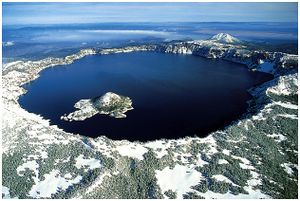 Crater Lake, Oregon, formed around 5,680 BC
Crater Lake, Oregon, formed around 5,680 BC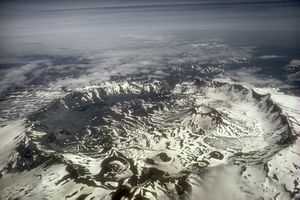 Aniakchak-caldera, Alaska
Aniakchak-caldera, Alaska- Mount Aniakchak (Aniakchak National Monument and Preserve) (Alaska)
- Crater Lake on Mount Mazama (Crater Lake National Park, Oregon)
- Mount Katmai (Alaska)
- La Garita Caldera (Colorado)
- Long Valley (California)
- Henry's Fork Caldera (Idaho)
- Island Park Caldera (Idaho, Wyoming)
- Newberry Volcano (Oregon)
- McDermitt Caldera (Oregon)
- Mount Okmok (Alaska)
- Valles Caldera (New Mexico)
- Yellowstone Caldera (Wyoming)
- Canada
- Silverthrone Caldera (British Columbia)
- Mount Edziza (British Columbia)
- Bennett Lake Volcanic Complex (British Columbia/Yukon)
- Mount Pleasant Caldera (New Brunswick)
- Sturgeon Lake Caldera (Ontario)
- Mount Skukum Volcanic Complex (Yukon)
- Blake River Megacaldera Complex (Quebec/Ontario)
- New Senator Caldera (Quebec)
- Misema Caldera (Ontario/Quebec)
- Noranda Caldera (Quebec)
- كولومبيا
- Arenas crater caldera, Nevado del Ruiz volcano, Caldas Department
- Laguna Verde caldera, Azufral volcano, Narino Department
- المكسيك
- Chile
- الإكوادور
- El Salvador
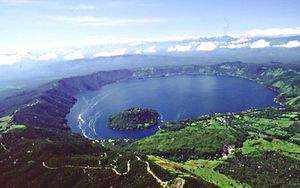 Coatepeque Caldera, El Salvador crater lake
Coatepeque Caldera, El Salvador crater lake - Guatemala
- Lake Amatitlán
- Lake Atitlán
- Xela
- Barahona
- Other
- Masaya (Nicaragua)
- آسيا
- شرق آسيا
- Dakantou Caldera (大墈头) (Shanhuyan Village, Taozhu Town, Linhai, Zhejiang، الصين)
- Ma'anshan Caldera (马鞍山) (Shishan Town (石山镇), Xiuying, Hainan، الصين)
- Yiyang Caldera (宜洋) (Shuangxi Town (双溪镇宜洋村), Pingnan County, Fujian، الصين)
- Aira Caldera (Kagoshima Prefecture, Japan)
- Kussharo (Hokkaido، اليابان)
- Kuttara (Hokkaido، اليابان)
- Mashū (Hokkaido، اليابان)
- Aso (Kumamoto Prefecture، اليابان)
- Kikai Caldera (Kagoshima Prefecture، اليابان)
- Towada (Aomori Prefecture، اليابان)
- Tazawa (Akita Prefecture، اليابان)
- Hakone (Kanagawa Prefecture، اليابان)
- Mount Halla (Jeju-do, South Korea)
- Heaven Lake (Baekdu Mountain, North Korea)
- Southeast Asia
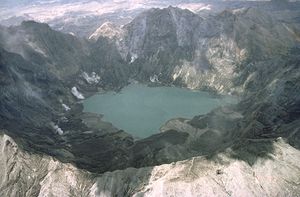 Mount Pinatubo, Philippines
Mount Pinatubo, Philippines- Apolaki Caldera (Benham Rise, Philippines)
- Corregidor Caldera (Manila Bay, Phillippines)
- Mount Pinatubo (Luzon, Philippines)
- Taal Volcano (Luzon, Philippines)
- Laguna de Bay (Luzon, Philippines)
- Batur (Bali, Indonesia)
- Krakatoa (Sunda Strait, Indonesia)
- Lake Maninjau (Sumatra, Indonesia)
- Lake Toba (Sumatra, Indonesia)
- Mount Rinjani (Lombok, Indonesia)
- Mount Tondano (Sulawesi, Indonesia)
- Mount Tambora (Sumbawa, Indonesia)
- Tengger Caldera (Java, Indonesia)
- جنوب غرب آسيا
- Derik (Mardin، تركيا)
- Nemrut (volcano) (تركيا)
- Russia
- Akademia Nauk (Kamchatka Peninsula)
- Golovnin (Kuril Islands)
- Karymsky Caldera (Kamchatka Peninsula)
- Khangar (Kamchatka Peninsula)
- Ksudach (Kamchatka Peninsula)
- Kurile Lake (Kamchatka Peninsula)
- Lvinaya Past (Kuril Islands)
- Tao-Rusyr Caldera (Kuril Islands)
- Uzon (Kamchatka Peninsula)
- Zavaritski Caldera (Kuril Islands)
- Yankicha/Ushishir (Kuril Islands)
- Chegem Caldera (Kabardino-Balkarian Republic, Northern Caucasus Region)
- شرق آسيا
- Europe
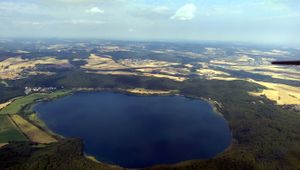
- Banská Štiavnica (سلوڤاكيا)
- Bakuriani/Didveli Caldera (جورجيا)
- Samsari (Georgia)
- Santorini (اليونان)
- Nisyros (Greece)
- Askja (آيسلندا)
- Grímsvötn (آيسلندا)
- Bárðarbunga (آيسلندا)
- Katla (آيسلندا)
- كرافلا (آيسلندا)
- Campi Flegrei (إيطاليا)
- Lake Bracciano (إيطاليا)
- Lake Bolsena (إيطاليا)
- Mount Somma which contains Mount Vesuvius (إيطاليا)
- Las Cañadas (Tenerife، اسبانيا)
- Glen Coe (اسكتلندا)
- Laacher See (ألمانيا)
- Lagoa das Sete Cidades & Furnas (São Miguel، الآزور، البرتغال)
- Oceania
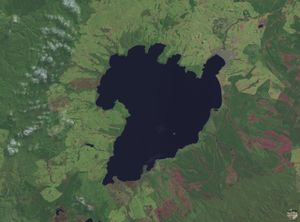 صورة ساتلية لـ بحيرة تاوپو
صورة ساتلية لـ بحيرة تاوپو- Cerberean caldera (Australia)[8]
- Kapenga (نيوزيلندا)
- Kilauea (Hawaii, US)
- Lake Ohakuri (نيوزيلندا)
- Lake Okataina (نيوزيلندا)
- Lake Rotorua (نيوزيلندا)
- Lake Taupo (نيوزيلندا)
- Maroa (نيوزيلندا)
- Moku‘āweoweo Caldera on Mauna Loa (Hawaii, US)
- Mount Warning (أستراليا)
- Prospect Hill (أستراليا)
- Rano Kau (Easter Island، تشيلى)
- Reporoa caldera (نيوزيلندا)
- أنتارتيكا
- المحيط الهندي
- المريخ
- Olympus Mons caldera
- كوكب الزهرة
- Maat Mons caldera
كالديرات بركانية
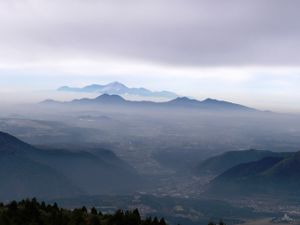


كالديرات متآكلة
. . . . . . . . . . . . . . . . . . . . . . . . . . . . . . . . . . . . . . . . . . . . . . . . . . . . . . . . . . . . . . . . . . . . . . . . . . . . . . . . . . . . . . . . . . . . . . . . . . . . . . . . . . . . . . . . . . . . . . . . . . . . . . . . . . . . . . . . . . . . . . . . . . . . . . . . . . . . . . . . . . . . . . . .
أنظر أيضا
ملاحظات
- ^ John, D. A. (1 February 2008). "Supervolcanoes and Metallic Ore Deposits". Elements. 4 (1): 22. doi:10.2113/GSELEMENTS.4.1.22.
- ^ "UMD: Precambrian Research Center". University of Minnesota, Duluth. Archived from the original on 4 March 2016. Retrieved 2014-03-20.
- ^ Ron Morton. "Caldera Volcanoes". University of Minnesota, Duluth. Retrieved 2015-07-03.
- ^ أ ب ت ث ج Parfitt, L.; Wilson, L. (Feb 19, 2008). "Volcanism on Other Planets". Fundamentals of Physical Volcanology. Malden, MA: Blackwell Publishing. pp. 190–212. ISBN 978-0-632-05443-5. OCLC 173243845.
{{cite book}}: Cite has empty unknown parameter:|chapterurl=(help) - ^ Gudmundsson, Agust (2008). "Magma-Chamber Geometry, Fluid Transport, Local Stresses and Rock Behaviour During Collapse Caldera Formation". Caldera Volcanism: Analysis, Modelling and Response. Developments in Volcanology. Vol. 10. pp. 313–349. doi:10.1016/S1871-644X(07)00008-3. ISBN 978-0-444-53165-0.
- ^ Chauhan, M.; Bhattacharya, S.; Saran, S.; Chauhan, P.; Dagar, A. (June 2015). "Compton–Belkovich Volcanic Complex (CBVC): An ash flow caldera on the Moon". Icarus. 253: 115–129. Bibcode:2015Icar..253..115C. doi:10.1016/j.icarus.2015.02.024.
- ^ Philip's World Reference Atlas including Stars and Planets ISBN 0-7537-0310-6 Publishing House Octopus publishing Group Ltd p. 9
- ^ Clemens, J.D.; Birch, W.D. (December 2012). "Assembly of a zoned volcanic magma chamber from multiple magma batches: The Cerberean Cauldron, Marysville Igneous Complex, Australia". Lithos. 155: 272–288. Bibcode:2012Litho.155..272C. doi:10.1016/j.lithos.2012.09.007.
المراجع
- Clough, C. T; Maufe, H. B. & Bailey, E. B; 1909. "The cauldron subsidence of Glen Coe, and the Associated Igneous Phenomena". Quarterly Journal of the Geological. Society. 65, 611-678.
- Gudmundsson, A (2008). Magma-Chamber Geometry, Fluid Transport, Local Stresses, and Rock Behavior During Collapse Caldera Formation. In Gottsmann J. & Marti, J (Ed. 10) Caldera Volcanism: Analysis, Modeling, and Response (314-346) Elsener, Amsterdam, The Netherlands
- Kokelaar, B. P; and Moore, I. D; 2006. Glencoe caldera volcano, Scotland. ISBN. 0852725252. Pub. British Geological Survey, Keyworth, Nottinghamshire. There is an associated 1:25000 solid geology map.
- Lipman, P; 1999. "Caldera". In Haraldur Sigurdsson, ed. Encyclopedia of Volcanoes. Academic Press. ISBN 0-12-643140-X
- Williams, H; 1941. Calderas and their origin. California University Publ. Geol. Sci. 25, 239-346.
- Wilson, E & Wilson, L (2008). Volcanism on Other Planets. In Fundamentals of Physical Volcanology (190-212) Malden, MA
وصلات خارجية
- USGS page on calderas
- List of Caldera Volcanoes
- Collection of references on collapse calderas (43 pages)
- The Caldera of the Tweed Volcano - Australia
- Largest Explosive Eruptions: New results for the 27.8 Ma Fish Canyon Tuff and the La Garita caldera, San Juan volcanic field, Colorado
- Supervolcanoes
المصادر
- ويكيبيديا انكليزي
- محمد أحمد حسن هيكل, منير (2008). أساسيات الجيولوجيا الفيزيائية. القاهرة، مصر: الدار العربية للكتاب.
{{cite book}}: Unknown parameter|coauthors=ignored (|author=suggested) (help)


